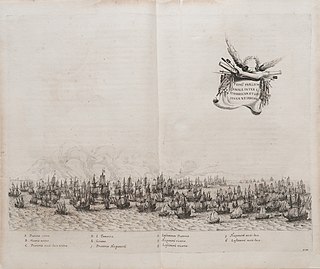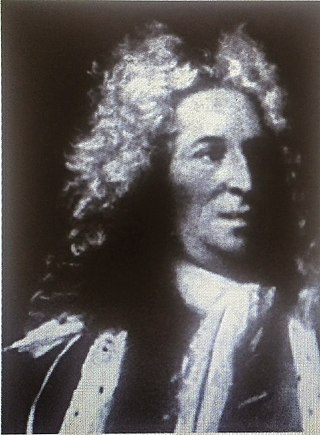
The naval Battle of Texel or Battle of Kijkduin took place off the western coast of the island of Texel on 21 August 1673 between the Dutch and the combined English and French fleets. It was the last major battle of the Third Anglo-Dutch War, which was itself part of the Franco-Dutch War (1672–1678), during which Louis XIV of France invaded the Republic and sought to establish control over the Spanish Netherlands. English involvement came about because of the Treaty of Dover, secretly concluded by Charles II of England, and which was highly unpopular with the English Parliament.

Ville de Paris was a large three-decker French ship of the line that became famous as the flagship of Admiral De Grasse during the American Revolutionary War.

Jean d'Estrées, Count of Estrées was a French Navy officer and nobleman who served during the reign of Louis XIV. He was born into an aristocratic family from Picardy. His aunt was Gabrielle d'Estrées, a mistress of King Henry IV of France.

Cornelis Evertsen the Youngest was a Dutch States Navy officer from Vlissingen who served as Lieutenant Admiral of Zeeland and Supreme Commander of the Dutch navy. Of a family that included several other naval admirals, including his father, Evertsen is noted for his distinguished service during the Second Anglo-Dutch War, Third Anglo-Dutch War, the Franco-Dutch War, the Glorious Revolution invasion, and the Battle of Beachy Head during the Nine Years' War.

HMS Latona was a 36-gun, fifth-rate frigate of the Royal Navy that served during the American Revolutionary War, the French Revolutionary Wars, and the Napoleonic Wars. Shortly after her launch in 1781, she participated in the Battle of Dogger Bank against a Dutch squadron in the North Sea. In September 1782, Latona took part in the relief of Gibraltar and was the first ship in the convoy to pass through the Straits, when Richard Howe sent her ahead, to spy on the condition of the Franco-Spanish fleet in Algeciras Bay.

The Battle of Lagos was a sea battle during the Nine Years' War on 27 June 1693, when a French fleet under Anne Hilarion de Tourville defeated an Anglo-Dutch fleet under George Rooke near Lagos Bay in Portugal. Rooke's squadron was protecting the Smyrna convoy, and it is by this name that the action is sometimes known.

HMS Centaur was a 74-gun third rate of the Royal Navy, launched on 14 March 1797 at Woolwich. She served as Sir Samuel Hood's flagship in the Leeward Islands and the Channel. During her 22-year career Centaur saw action in the Mediterranean, the Channel, the West Indies, and the Baltic, fighting the French, the Dutch, the Danes, and the Russians. She was broken up in 1819.

HMS Essex was a 70-gun third rate built by Sir Henry Johnson of Blackwall in 1678/79. During the War of the English Succession she fought in the last major action. She was rebuilt in 1699/1700. During the War of Spanish Succession she fought at Vigo Bay, the Capture of Gibraltar and Velez Malaga. She also fought at the Battle off Passero in 1718. She was rebuilt again in 1736-40. She was in action off Toulon in 1744. She was active in the Channel and against French ports during the Seven Years War. She fought at Quiberon Bay in 1759. She was wrecked in Quiberon Bay in November 1759.

The action of 12–17 January 1640 was a naval battle between a Dutch fleet and a combined Spanish-Portuguese fleet during the Eighty Years' War. The battle took place on the Brazilian coast off Pernambuco and was an attempt by a fleet consisting of approximately eighty vessels transporting about 5,000 soldiers under the command of Portuguese Admiral Fernando de Mascarenhas to land reinforcements to bolster the Portuguese militia besieging the city of Recife. On 12 January this fleet was intercepted by a Dutch task force of about forty ships commanded by Willem Loos. The ensuing battle lasted with occasional breaks until the evening of 17 January, when the Spanish and Portuguese fleet retreated and sailed away to the north.

Hendrik Carloff, Caerloff or Caarlof was an adventurer and slave trader active in the 17th century. Carloff began his career as a cabin boy but rose to become a commander and governor appointed by the Dutch West India Company and Danish or the Swedish Africa Company on the Gold Coast. Between 1676 and 1677, he was Governor of Tobago.

Rear-Admiral John Bligh CB was an officer in the Royal Navy who served during the American War of Independence and the French Revolutionary and Napoleonic Wars.

Fort Cépérou was a fort that protected the city of Cayenne, French Guiana. It is named after Cépérou, a celebrated indigenous chief who ceded the land.

Admiral Sir John Harman was an English officer of the Royal Navy, who served first under the Commonwealth, then Charles II following the 1660 Stuart Restoration.
Charles de Courbon, comte de Blénac was a French military officer, nobleman and colonial administrator who served as governor general of the French Antilles during the 17th century. He was an experienced soldier and fought for the king during the Fronde before becoming a naval officer in the French Navy. Towards the end of the Franco-Dutch War he led the land forces that captured Tobago from the Dutch before taking command of the French Antilles. During the Nine Years' War he was active in the struggle with the English and Dutch in the Windward Islands. He captured Sint Eustatius and Saint Kitts, and defended Martinique against a large English expedition in 1693.
Jean-Charles de Baas-Castelmore, marquis de Baas was governor and lieutenant general of the French Antilles from 1669 to 1677. As a young man he became a soldier during the Franco-Spanish War (1635–59), and participated in the Fronde rebellion of 1648–53. King Louis XIV of France pardoned him for this, and he played an important role in the fighting in Italy. After being made governor general of the Antilles he transferred the administrative center from Saint Christopher Island to the more strategically located and economically important Martinique. He had to deal with constant crises in supplies caused by the (often-ignored) ban on trading with the English and Dutch. He improved the administration, developed the defenses of Fort Royal, and helped fight off an attempted Dutch invasion in 1674.

Thomas Claude Bernard Renart de Fuschamberg, marquis d'Amblimont was a French Navy officer, nobleman and colonial administrator who served as governor general of the French Antilles. He is best known for his 1674 defense of Martinique against Dutch forces under Admiral Michiel de Ruyter, where he was captain of a warship that played a critical role in driving the Dutch land forces off their beachhead.
Charles-François de Machault de Belmont was a French Navy officer and colonial administrator who served as governor general of the French Antilles from 1703 to 1709. He held office during the War of the Spanish Succession, when the French colony on Saint Kitts was lost to the English and the other islands were under constant threat.

The Dutch Raid on North America took place from December 1672 to February 1674 during the Third Anglo-Dutch War, a related conflict of the Franco-Dutch War. A naval expedition led by Cornelis Evertsen the Youngest and Jacob Binckes attacked English and French possessions in North America.
At least four ships of the French Navy have borne the name Le Glorieux:

On 9 August 1673, during the Third Anglo-Dutch War a combined Dutch fleet commanded by Cornelis Evertsen the Youngest of the Admiralty of Zeeland and Jacob Binckes of the Admiralty of Amsterdam recaptured New York, which had been English since the Peace of Breda of 1667. The town of New York was re-christened "New Orange" and New Netherland was re-established as a Dutch colony under governor-general Anthony Colve. The Dutch Republic, however, returned the colony to English rule under the Treaty of Westminster (1674), in exchange for the colony of Suriname, which eventually led to the replacement of governor Colve by governor Edmund Andros on 10 November 1674 (N.S.)















